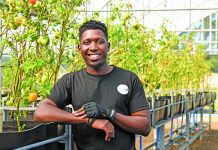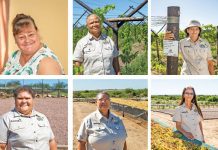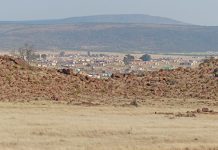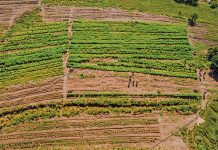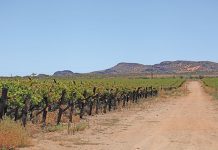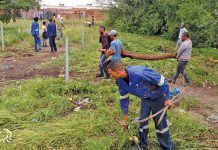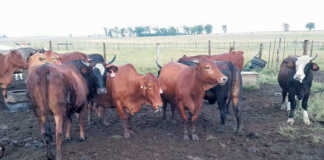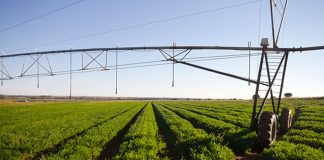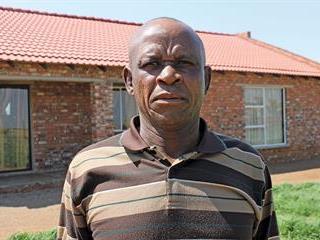
Despite government’s land reform programme’s high failure rate, one successful beneficiary has beat the odds and has now requested more land to enable him to become a commercial farmer. Seventy-year-old Salphanius Motswenyane farms on 203ha on Tweebuffelsgeschiet in the Grootpan area near Coligny in platinum-rich North West.
He grew up in a farming environment and worked on Fielies van Rensburg’s farm near Taaiboschspruit as a young man. Armed with this background and 20 years’ experience as a clerk at the Mooifontein Agricultural Co-operative, he approached the Department of Rural Development and Land Reform for a farm and received land in 2012. His contract will expire in 2017 and is subject to renewal.
Getting started
The farm, according to Salphanius, was in a fairly good condition when he received it “but there were a lot of stones and it had been lying fallow for about four years before it was allocated to me by the department”. To get him started, the department also provided him with a tractor, a planter, an offset disc harrow and ripper, fertiliser, pesticide and herbicide, as well as 8 800l of diesel. He recently harvested 50ha of white maize, achieving 1,8t/ ha, 50ha of yellow maize with a yield of 0,9t/ha, and 50ha of sunflower, which yielded 1,2t/ha.
READ: How government fails smallholder farmers
Livestock grazing
The rest of the farm is used for grazing. His Bonsmara herd of 12 calves, 12 cows and one bull graze the farm’s Smuts finger (Digitaria eriantha) pasture. Salphanius admits that he initially had no experience of livestock farming. “My main focus is grain farming and I’m no expert at keeping Bonsmaras, but people say they have a good temperament. My aim is to keep them until they are old enough and sell them to a feedlot in Rustenburg for profit.
“My background is in maize and sunflower production, so it was a no-brainer that I chose to focus on what I know best when I received the farm. That said, I would like to try my hand at soya beans because they fetch high prices on the market. One ton sells for about R6 000 at current rates,” he says.
Training and development
Several certificates adorn Salphanius’s living room wall. He says he has been involved in Grain SA for a “very long time” and has attended numerous lectures and courses offered by this organisation. These include a maize production course (2008), sunflower production course (2008), leader farmer course (2004), and ITO Focus International merit award (2009).
He also completed Grain SA’s contractors’ certificate with modules including agricultural contracting, soil and plant roots, tillage, crop planting, spraying for weeds, pest control, and tractor maintenance. Salphanius’s commitment to training and development was acknowledged recently when he was included in the line-up of finalists in the 2015 Grain SA/Syngenta Smallholder Farmer of the Year competition.
READ Teamwork: essence of the Dutch co-op
According to Salphanius, the criteria for the competition was that farmers should be farming “on anything from 10ha, but producing less than 250t of grain”. Salphanius is eager to discuss the production side of his R1,3 million/ annum enterprise.
“My seeding rate is as follows: for maize, I plant about 18 000 seeds/ha and for sunflower 35 000/ ha to 38 000 seeds/ha. My spacing between rows for maize is 15cm, as this gives them some breathing space and exposure to sunlight which is a prerequisite for crops to grow and mature,” he explains.
Every year, Salphanius rotates sunflower plantings with maize crops.The farm’s three permanent employees assist Salphanius with the hard manual work. To prepare the soil for planting, he uses his offset disc to cultivate the soil, and then the wing-blade ripper and the seedbed harrow. Maize seed is planted at a depth of between 5cm and 10cm and sunflower seed at about 5cm, he says.
Future plans
“I want to build a piggery because pigs generate a good income. I just want something that will supplement the money
I get from maize and sunflower. I got the idea about pigs during the drought period. “It hurts my business badly because I farm on land that is dry. I make an annual turnover of about R1,3 million but due to the drought I made only about R700 000 this year. I barely managed to pay my debts. Hopefully, things will be better in the coming planting season once we get some good rain,” he says.
Salphanius supplies NWK in Coligny and Bodenstein with maize and sunflower and has requested more land from government. “[My farm of] 203ha is too small. I want more land. I want to be a big farmer. I want to have my own farm that is registered in my name.”
Phone Salphanius Motswenyane on 078 717 5013.

